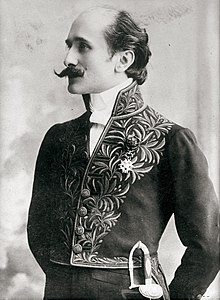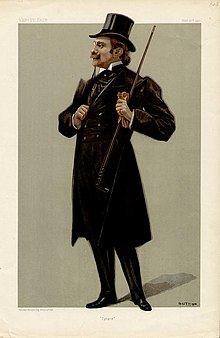Edmond Rostand
Edmond Rostand | |
|---|---|
 Rostand in the uniform of the Académie française, 1905 | |
| Born | Edmond Eugène Alexis Rostand 1 April 1868 Marseille, France |
| Died | 2 December 1918 (aged 50) Paris, France |
| Occupation | Poet, playwright |
| Literary movement | Neo-romanticism |
| Spouse | Rosemonde Gérard |
| Children | Jean Rostand Maurice Rostand |
Edmond Eugène Alexis Rostand (
Early life
Rostand was born in Marseille, France, into a wealthy and cultured Provençal family. His father was an economist, a poet who translated and edited the works of Catullus,[4] and a member of the Marseille Academy and the Institut de France. Rostand studied literature, history, and philosophy at the Collège Stanislas in Paris, France.
Career
When Rostand was twenty years old, his first play, a one-act comedy, Le Gant rouge, was performed at the Cluny Theatre, 24 August 1888, but it was almost unnoticed.[4]
He and his fiancée Rosemonde Gérard became friends with Emmanuel Chabrier in 1889, and the composer quickly set three of his poems (and two of hers) to music;[5] the following year the two collaborated on À la musique for the house-warming of a mutual friend.[6] In 1890, Rostand published a volume of poems called Les Musardises.[7] The same year he offered a one-act Pierrot play in verse to the director of the Théâtre François. This gave him the opportunity to write for the state theatre a three-act play, also in verse, as are all Rostand's plays. He considered himself a poet, whether writing plays or poetry.
The resulting play, Les Romanesques, was produced at the Théâtre François on 21 May 1894. It was a great success and was the start of his career as a dramatist. This play would be adapted in 1960 by
Rostand's next play was written for Sarah Bernhardt. La Princesse Lointaine was based on the story of the 12th-century troubadour Jaufre Rudel and his love for Hodierna of Jerusalem (who is the archetypal princesse lointaine character). This idealistic play opened on 5 April 1895, at the Théâtre de la Renaissance. The part of Melisandre (based on Hodierna's daughter Melisende of Tripoli) was created by Sarah Bernhardt[8] but the play was not particularly successful. When Bernhardt performed it in London later the same year, it received a bad review from George Bernard Shaw but this was not surprising considering Shaw's bias for realism.[4] Rambaldo di Vaqueiras: I Monferrato, 1922 1922 verse drama by Nino Berrini(it) is based on La Princesse Lointaine.
Bernhardt, undeterred, asked Rostand to write another play for her. She created the role of Photine in La Samaritaine (Theatre de la Renaissance, 14 April 1897), a Biblical drama in three scenes adapted from the gospel story of the woman of Samaria.[8] This play was more successful and became part of Sarah Bernhardt's repertoire. Rostand felt satisfied that he had proven to the public that he was something more than a writer of comedies.[4]
The play
In 1901, Rostand became the youngest writer ever to be elected to the
The Romancers one act play is one of Edmond Rostand's most famous plays. This play is found to be read for study in the courses of many universities of the world.[11]
When he died prematurely at fifty years old, Rostand was still writing plays. "La Dernière Nuit de Don Juan" was performed posthumously in 1922. There were two unfinished and unpublished plays – Yorick and Les Petites Manies.[12]
Personal life

Rostand was married to the poet and playwright Rosemonde-Étiennette Gérard who, in 1890, published Les Pipeaux: a volume of verse commended by the Academy.[8] The couple had two sons, Jean and Maurice.
During the 1900s, Rostand came to live in the Villa Arnaga in
Works
- Le Gant rouge, 1888 (The Red Glove)
- Les Musardises, 1890
- Les Deux Pierrots, ou Le Souper blanc (The Two Pierrots, or The White Supper), 1891
- Les Romanesques,[13][14] 1894 (basis for the 1960 off-Broadway musical The Fantasticks)
- La Princesse Lointaine (The Princess Far-Away),[15][16] 1895
- La Samaritaine (The Woman of Samaria), 1897
- Cyrano de Bergerac, 1897
- L'Aiglon: A Play in Six Acts. 1900
- Chantecler: A Play in Four Acts, 1910
- La Dernière Nuit de Don Juan (The Last Night of Don Juan, in Poetic Drama), 1921
- Le Cantique de L'Aile, 1922
- Le Vol de la Marseillaise, 1922
See also
References
- ^ "Rostand, Edmond". Lexico UK English Dictionary. Oxford University Press. Archived from the original on 31 August 2022.
- ^ "Rostand". The American Heritage Dictionary of the English Language (5th ed.). HarperCollins. Retrieved 5 August 2019.
- ^ "Rostand". Merriam-Webster.com Dictionary. Retrieved 5 August 2019.
- ^ a b c d e William Lyon Phelps (1921) Essays on Modern Dramatists, Macmillan, New York
- ^ Delage, Roger (1999). Emmanuel Chabrier (in French). Paris: Fayard. ISBN 978-2-213-60508-1. p525f.
- OCLC 1002911049
- ^ a b Annual Register for the Year 1918 (1919) Longmans, Green and Company, London – New York
- ^ a b c d e f g One or more of the preceding sentences incorporates text from a publication now in the public domain: Chisholm, Hugh, ed. (1911). "Rostand, Edmond". Encyclopædia Britannica. Vol. 23 (11th ed.). Cambridge University Press. p. 754.
- ^ a b "Feature: Edmond Rostand". Sydney Theatre Company. 1 November 2014. Archived from the original on 28 January 2022. Retrieved 2 December 2014.
- ISBN 9780838632673.
- ^ "The Romancers by Edmond Rostand - Class 12 Mero Notice". Mero Notice. 23 February 2021. Retrieved 27 February 2021.
- ^ Contemporary Authors Online (2003) Gale, Detroit
- ^ Edmond Rostand (1903) Les Romanesques: comédie en trois actes, en vers (Google eBook) (in French)
- ^ Edmond Rostand (1915) The Romancers: Comedy in Three Acts, translated by Barrett H. Clark, Samuel French (Google eBook)
- ^ Edmond Rostand (1909) La Princesse Lointaine, Charpentier et Fasquelle, Paris (Google eBook) (in French)
- ^ Edmond Rostand (1921) The Princess Far-away: A Romantic Tragedy in Four Acts, translated by Anna Emilia Bagstad, R.G. Badger, Boston (Google eBook)
Sources
- Edmond Rostand: Cyrano de Bergerac, ISBN 978-1-85459-117-3
- Henry James in vol. 84, pp. 477 seq. The Cornhill Magazine.
- Marcel Migeo: Les Rostand, Paris, Stock, 1973. About Edmond, his wife Rosemonde, and their sons Jean and Maurice Rostand.
- Sue Lloyd: The Man who was Cyrano, a Life of Edmond Rostand, Creator of 'Cyrano de Bergerac', Genge Press, USA, 2003; UK 2007. ISBN 978-0-9549043-1-9
External links
 French Wikisource has original text related to this article: Edmond Rostand
French Wikisource has original text related to this article: Edmond Rostand- Petri Liukkonen. "Edmond Rostand". Books and Writers.
- Works by Edmond Rostand at Project Gutenberg
- Works by or about Edmond Rostand at Internet Archive
- Works by Edmond Rostand at LibriVox (public domain audiobooks)

- French text of Rostand's La princesse lointaine Archived 18 July 2011 at the Wayback Machine
- Home revised web site set up by Genge Press, UK to celebrate Rostand's life and work
